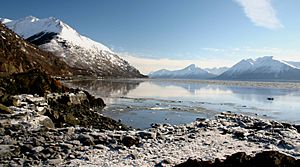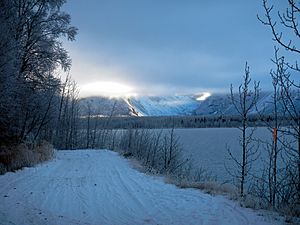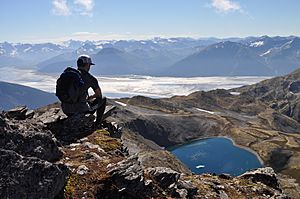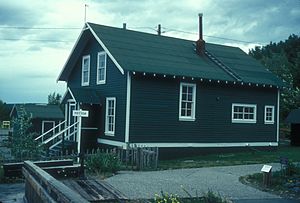Chugach State Park facts for kids

Chugach State Park is a huge park in south-central Alaska, covering about 495,204 acres (2,004 square kilometers). It's right next to Anchorage, a major city. Most of the park is in Anchorage, but a small part is in the Matanuska-Susitna Borough.
The park was created on August 6, 1970, by Alaska Governor Keith Miller. Its main goals are to offer fun outdoor activities, protect the beautiful Chugach Mountains and other natural spots, and keep Anchorage's water supply safe. Chugach State Park is managed by Alaska State Parks. It's the third-largest state park in the United States! Only Anza-Borrego Desert State Park in California and Wood-Tikchik State Park in western Alaska are bigger. You can go hunting and fishing in Chugach, but you need to follow the rules set by the Alaska Department of Fish and Game. Target practice is not allowed.
Eklutna Lake
The Lakeside Trail is a long path, about 12.7 miles (20.4 kilometers), that follows the edge of Eklutna Lake. It leads to the Eklutna Glacier Trail, which quickly takes you to the giant blue ice of Eklutna Glacier.
In summer, you can explore the trail by walking, biking, ATV, or even on horseback. The trail is mostly flat, making it easy to reach the glacier. For more adventurous hikers, there's a 31-mile (50-kilometer) route with three huts. It crosses several glaciers and ends near Girdwood.
In winter, you can use snowmobiles, snowshoes, or cross-country skis on the same trail, depending on the rules and weather. Since much of the trail is an old road, it's a popular spot for skijoring (being pulled by a dog on skis) and dogsledding.
There are two remote campgrounds and one main campground open in summer. You can also rent two public cabins along the Lakeside Trail. Only non-motorized boats or boats with electric motors are allowed on Eklutna Lake. The park's tallest point, Bashful Peak, stands tall over the lake at 8,005 feet (2,440 meters). Small bush planes can land on the far side of Eklutna Lake at the Bold Airstrip.
Around Eklutna Lake, you'll see many different plants. At lower elevations, thick forests of white spruce, paper birch, and quaking aspen trees grow. The forest floor is covered with ferns, mushrooms, and wildflowers like dwarf dogwood and fireweed.
Higher up, you'll find beautiful wildflowers like mountain avens and Alaska's state flower, the alpine forget-me-not. Other plants like alpine milkvetch and wild geranium grow on lower slopes. Even higher, you'll see nootka lupine, coastal paintbrush, and finally, the mosses of the tundra.
Berry picking is a fun activity in late summer and early fall. You can find highbush cranberries, lingonberries, northern redcurrants, and bog blueberries along the lower trails. Higher up, look for dwarf blueberries, alpine bearberries, and crowberries. Always be sure to know what kind of berry it is before you eat it, as some are poisonous.
Eagle River


The Eagle River Nature Center is run by a non-profit group. It has cool exhibits about the park's wildlife and geology. You can reach the Eagle River area by taking the Albert Loop Trail, a three-mile (five-kilometer) path through mixed forests. It leads to a river fed by hidden glaciers. Sometimes, in the fall, this trail closes when bears are fishing for salmon to keep people and bears safe.
Another path, the Rodak Nature Trail, leads to a viewing deck where you can watch beavers and salmon. In August, you can often see red salmon and silver salmon swimming upstream to lay their eggs. Brown bears and grizzly bears often eat salmon in the shallow water near beaver dams. Hundreds of black bears also live in the park.
The streams in this area are great for bird watching. You might spot the American dipper in winter. Bird watchers can also listen for the calls of the great horned owl and boreal owl during the colder months. You can rent yurts and cabins along the Eagle River to stay and explore the beautiful scenery and wildlife. Camping is also available at the Eagle River Campground.
The Historic Iditarod Trail, also known as the Crow Pass Trail, goes past the nature center. This popular trail is 28 miles (45 kilometers) long and connects Eagle River to Girdwood. It crosses the Chugach Mountains and offers amazing views and chances to see wildlife. Even on the first few miles, hikers often see hoary marmots and Arctic ground squirrels. Sometimes, you might even spot mountain goats or Dall sheep.
Hoary marmots live in alpine meadows, often near large rocks. These furry animals sleep through the winter from mid-September until April or May. In summer, you can hear their long whistle warning calls. Mountain goats and their babies, and Dall sheep with their lambs, can be seen eating on the slopes above the trail in late spring and summer. It's easy to mix them up, but mountain goats have long leg hairs that look like pants!
Hillside
The Hillside Trail System is only about 20 minutes east of downtown Anchorage. A private shuttle can take you from downtown to the Glen Alps Trailhead. From the trailhead, there's a short, wheelchair-friendly walk of about a quarter mile (0.4 kilometers) to a viewing deck. From here, you can see the city, the Cook Inlet, and even the Alaska Range about 80 miles (129 kilometers) away!
This trailhead is also the main way to get to Flattop Mountain, which is the most hiked peak in Alaska. In winter, some trails here can have avalanches, so hikers should always check conditions before going. The Powerline Pass Trail is a popular place for dogsledding and skijoring.
While you might see moose on many park trails, a good place to spot them is the viewing platform at Glen Alps in fall and early winter. Dozens of moose are often seen below the platform and across the Campbell Creek Valley. Wolves and Canadian lynx also live in the park but are harder to spot.
The willow ptarmigan, Alaska's state bird, along with the rock ptarmigan and white-tailed ptarmigan, are often found in the alpine tundra and shrub areas. Meadow voles live underground in these habitats. Hikers might hear the chirps of singing voles. In the fall, these small rodents build piles of grasses near their homes.
Smaller animals in this area include red foxes, porcupines, hares, ground squirrels, ermines, and pikas.
Turnagain Arm

The Seward Highway runs along the southern edge of the park next to Turnagain Arm. This part of the highway is a National Scenic Byway and an All-American Road, meaning it's a very beautiful drive.
Along the Seward Highway, you'll find the park headquarters at the Potter Section House State Historic Site. This used to be an important camp for workers on the Alaska Railroad. There are several great viewpoints along the highway. One popular spot is Beluga Point, named because beluga whales often visit the area. Another good viewpoint is Windy Corner, where you can often see Dall sheep on the hill.
The McHugh Creek Day Use Area has hiking trails and picnic spots. The Bird Creek Campground is south of Anchorage off the Seward Highway. All campgrounds in the park offer wooded spots, fire rings, picnic tables, drinking water, and restrooms. Park volunteers are often there to help visitors. Firewood is usually available for a small fee. While dirt bikes are not allowed, the Bird Valley Trail System is the only place in the park where ATVs are allowed all year.
Turnagain Arm has the second highest tides in North America, after the Bay of Fundy. These tides can reach 40 feet (12 meters) and sometimes come in so fast that they create a wave called a bore tide. Brave kayakers and surfers sometimes ride this wave as an extreme sport. Hikers should be careful not to get stuck in the quicksand-like mudflats along the beaches of Turnagain Arm. The best place to see the Alaskan bore tide is along the Seward Highway south of Anchorage, especially at Bird Point.
Bear Safety
Chugach State Park is a wild place, and it's home to many bears, including black bears and brown bears (grizzlies). When you visit the park, it's important to know how to stay safe around wildlife. Always make noise when hiking so bears know you are there. Carry bear spray and know how to use it. If you see a bear, give it plenty of space and never approach it. Keep food stored safely and clean up any trash to avoid attracting bears. Being aware and prepared helps everyone enjoy the park safely.
See also
 In Spanish: Parque estatal de Chugach para niños
In Spanish: Parque estatal de Chugach para niños






